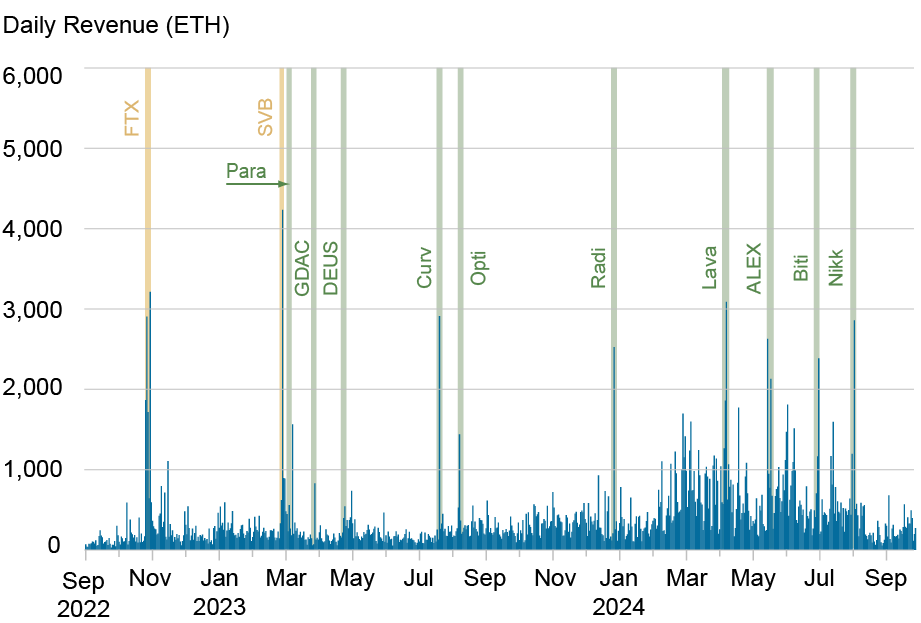

Forums
Talk about anything you want!
Login to get your referral link.
Pablo D. Azar, Adrian G. Casillas and Maryam Farboodi

In our previous Liberty Street Economics Post, we have introduced the decentralized finance intermediation chain (DEFI) and explained how various actors have become key intermediaries in Ethereum ecosystem. In this article, we summarize the empirical results in our new Staff report This explains how the need for confidentiality of transactions through the DEFI intermediation chain gives rise to the market power of intermediaries.
We collect data from September 2022 (when Ethereum went to a consensus algorithm of proof of implementation) at September 2024. Our data covers more than 5,326,069 blocks added to the Ethereum blockchain. For each block, we follow who built it, who proposed it, how many income it has generated, how these income are divided between the manufacturers and the proponents, and what transactions are public or private. This full data set allows us to map the relationships between the different actors of the Ethereum ecosystem and to understand the economic incentives at stake.
Our main objective is to understand how access to private transactions affects the share of the profits of a block manufacturer. Private transactions often represent precious arbitration opportunities that manufacturers want to keep secret until the block is added to the chain. If manufacturers with access to more precious private transactions can constantly enter a larger share of profits, this suggests that the information asymmetry between block manufacturers plays a crucial role in the distribution of profits between intermediaries.
The measurement of this effect is not simple because of the complex dynamics of the Ethereum network. Bloc manufacturers make several decisions simultaneously: private and public transactions to include, and the amount of profit that results in sharing with the proponents. In addition, other factors such as the overall revenues of the block and the existing relationships between manufacturers and the proponents could influence the sharing of profits.
These interconnected decisions make it difficult to disentangle the cause and the effect. Does a manufacturer get a larger share of profit because it included precious private transactions, or do they include more private transactions because they know that they can negotiate better profit action?
To overcome these challenges, we use a technique known as an instrumental variable analysis, which exploits natural experiences. A natural experience occurs when an external event creates a variation of the variables we study, without being directly caused by the result we are studying. This approach allows us to observe the effects of changes in a system when we do not have the capacity to attribute to random treatments, and is particularly precious when we study complex phenomena of the real world such as financial markets.
In our study, we identify two types of unexpected events that serve as instruments: crypto protocol hacks and major cryptography market (such as the race on Silicon Valley Bank and FTX bankruptcy). These events affect transaction models on the Ethereum network predictably, but above all, they are not caused by changes in the sharing of profits between manufacturers and proponents.
The graph below shows a chronological series of Ethereum daily income, with cryptographic crises highlighted in yellow, and selected hacks highlighted in green. He illustrates that income tends to increase during these unexpected events, leading to a large amount of profit that must be divided between block manufacturers and proponents.
Global block income at a daily level

Although the two types of events tend to increase income, our key overview is that they affect the proportion of public and private transactions in the block in different ways. The crises generally increases public and private transactions as users rush to move their assets or capitalize on market volatility. The hacks, on the other hand, tend to create more opportunities for private transactions of the initiated type, because those who have early knowledge of the pirat try to protect their assets or exploit the situation. Because hacks tend to have more private information, they will lead to a larger share of profits for the manufacturer, who is the only one to have access to this information.
The main advantage of this approach is that these events cause changes in transaction models which are not caused by the strategic decisions taken by manufacturers and the proponents concerning the strengthening of profits. This independence allows us to use these events as an instruments to measure more precisely how the changes in the value of private transactions affect the manufacturer’s benefits. By analyzing the network’s response to these external shocks, we can draw more reliable conclusions on the causal relationship between access to private transactions and the capacity of a manufacturer to grasp the profits in the DEFI ecosystem, while controlling other factors that could influence strengthening decisions.
Using our instrumental variable approach, we discover convincing evidence that private information shape the sharing of profits along the DEFI intermediation chain. Our analysis reveals a strong positive relationship between the value of private transactions in a block and the share of the manufacturer’s profits. Quantitatively, we estimate that an increase of 1% of the value of private transactions leads to an increase of 0.57% of the share of the manufacturer’s profits.
This result suggests that block manufacturers derive significant market power from their ability to attract and include precious private transactions. Manufacturers who are constantly accessing profitable private arbitration opportunities or other high -value private transactions may take advantage of this information to enter a larger share of block income.
Above all, during the control of the value of private transactions, we note that higher overall overall incomes in fact decrease the share of the manufacturer’s benefits and increase the share of the proponent. This indicates that public transactions, accessible to all manufacturers, do not contribute to the market power of a manufacturer even when they are very profitable. Rather, this is the exclusive access to private transactions which offers manufacturers a competitive advantage in negotiations with the proponents.
These results paint a table of a DEFI ecosystem where information asymmetry plays a crucial role in determining economic results. Bloc manufacturers who can position themselves as precious private information guards can extract higher rents from the system. This dynamic creates incentives to manufacturers to invest in technologies and relationships that give them better access to private transactions, which leads to an additional concentration of market power.
Our results reveal a paradox of DEFI: despite its decentralized technology, the ecosystem shows significant centralization trends. This does not only count for crypto lovers, but more and more for the wider financial world.
The main reason is the growing interconnection between DEFI and traditional finance. While large financial institutions are part of the DEFI space through vehicles such as the funds (ETF) negotiated in exchange for Ethereum, they can become participants in the DEFI intermediation chain. These institutions, with their resources and their potential access to private information, could further concentrate market power within DEFI.
This development creates a new interaction channel between decentralized and traditional financial systems. If some key players dominate critical functions in DEFI because of their information advantage, it could introduce new dynamics similar to those of traditional finance. These main DEFI players could potentially influence the wider financial system, even affecting those who have never interacted directly with Crypto or Defi.
For decision -makers and regulators, understanding these dynamics is important for effective monitoring that balances innovation with financial stability. For the general public, awareness of these trends gives an overview of the evolution of financial systems which may indirectly have an impact on traditional financial services. As DEFI and traditional finance become more linked, the implications of this centralization extend to the larger financial landscape, potentially affecting a wide range of participants in the modern economy.

Pablo Azar is an economist of financial research in money and payment studies in the research group and statistics of the Federal Bank of the New York Reserve.
Adrian G. Casillas is a technical associate with the MIT Sloan School of Management.
Maryam Farboodi is the Jon D. Gruber Associate Professor for Career Development and Associate Professor of Finance at MIT Sloan School of Management.
How to quote this post:
Pablo D. Azar, Adrian G. Casillas and Maryam Farboodi, “The origins of market power in Defi”, Federal Reserve Bank of New York Liberty Street EconomicsApril 21, 2025,
Non-liability clause
The opinions expressed in this position are those of the authors and do not necessarily reflect the position of the Federal Reserve Bank of New York or the Federal Reserve System. All errors or omissions are the responsibility of the authors.
post url: https://altcoin.observer/the-origins-of-market-power-in-defi/
1
Voice
0
Replies
